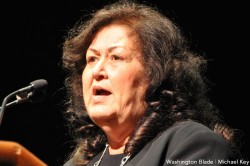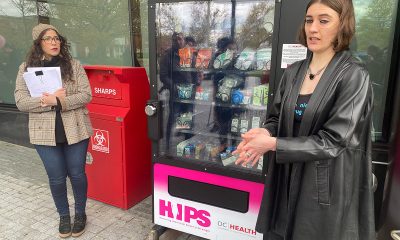Health
AIDS experts express hope at ‘Return to Lisner’
Whitman-Walker commemorates D.C.’s first AIDS forum 29 years ago
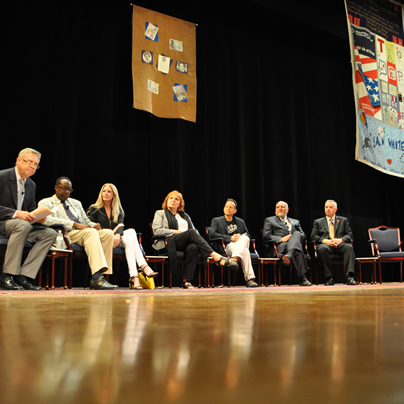
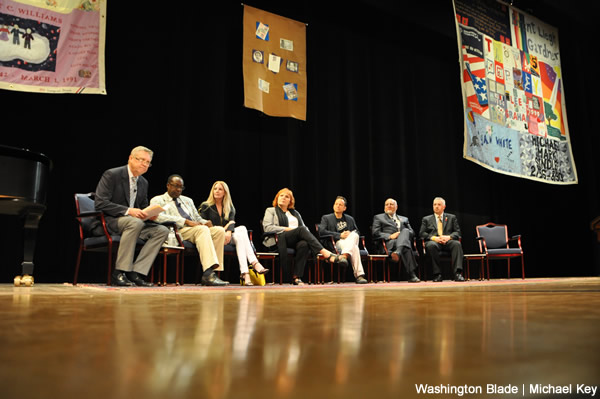
A panel of experts discussed the state of the AIDS epidemic Tuesday night at Lisner Auditorium, the same place where D.C.’s first AIDS forum was held 29 years earlier. (Washington Blade photo by Michael Key)
A panel of experts in the fields of AIDS-related medicine, research, public policy, and education discussed the state of the AIDS epidemic Tuesday night at George Washington University’s Lisner Auditorium, the same place where D.C.’s first AIDS forum was held 29 years earlier.
Tuesday’s forum followed an impassioned keynote address by Jeanne White-Ginder, mother of Ryan White, the Indiana teenager who was diagnosed with AIDS in 1984 at the age of 14. White, a hemophiliac who contracted the virus from contaminated blood products, became an internationally recognized advocate for AIDS research and education before he died in 1990.
D.C. Council member Jim Graham (D-Ward 1), who served as president of the Whitman-Walker Clinic at the time of the first AIDS forum at Lisner Auditorium in 1983, shared his recollection of the earlier forum at Tuesday’s event.
“When we came here to Lisner with nearly every seat filled on April 4, 1983, there was one thing that was certain,” he said. “And that was that something potentially devastating was about to happen. And we had to arm ourselves. We had to get ready.”
Graham noted that the 1983 forum was held at a time when little was known about the cause of AIDS and how it was transmitted. Although there were just a handful of reported cases in D.C., the city’s politically influential gay community was aware of the growing number of cases in New York, San Francisco, and other large U.S. cities, where otherwise healthy gay men were dying within months of being diagnosed with the disease.
“At a time when there was no Twitter, no Facebook, no Internet, no websites, 1,100 persons showed up on that night to find out what this was all about,” Graham said. “We believed then as we do now that if we could muster the will to marshal the resources we could stop AIDS dead in its tracks and we could care for those in dire need.”
The auditorium was about two-thirds full at Tuesday night’s forum.
Activists looking back at the early years of AIDS have often referred to that period as the “dark days,” when friends and loved ones died in increasing numbers.
With that as a backdrop, the panelists at Tuesday’s forum, while saying much still remains to be done, pointed to the dramatic scientific advances in the ensuring 29 years that have transformed an HIV infection from a near-certain death sentence to a chronic but manageable condition in which a person with HIV can live a normal lifespan.
“I think hope shines bright,” said Jose Zuniga, president of the International Association of Physicians in AIDS Care.
“We have saved millions of lives through the provision of antiretroviral therapies,” Zuniga told the forum.
“This hope also serves to shine a light on the inequalities, the inequities, all the horrible – the racism, sexism, homophobia, trans phobia that are all barriers to our achieving the goals we have in mind,” said Zuniga. “Having said all of that, I remain highly hopeful and optimistic.”
Robert Redfield, chief of Infectious Diseases and director of HIV programs at the University of Maryland, said he was hopeful that further advances in antiretroviral drugs will lead to a “functional cure” of HIV infection before the end of this decade.
Redfield said researchers define a functional cure as the ability of an as yet to be developed drug or drug combination to permanently suppress the viral load in a person with HIV to a point where it is undetectable and the person no longer needs to take anti-retroviral drugs.
Currently, people with HIV whose viral level is undetectable through the use of existing antiretroviral drugs experience a relapse, with the virus reemerging in large numbers after the person stops taking the prescribed regimen of the drugs.
According to Redfield, researchers are getting closer to developing improved drugs that can seek out and destroy the ‘hidden’ forms of HIV that remain dormant in patients taking the current drug regimens but that reemerge if the patient stops taking the drugs.
In addition to Zuniga and Redfield, the other panelists included A. Cornelius Baker, former Whitman-Walker Clinic executive director and senior communications adviser and project director for a D.C.-based international consulting organization that addresses AIDS issues; Regan Hofmann, editor of POZ magazine; JoAnne Keatley, director of the Center of Excellence for Transgender Health at the University of California-San Francisco; and Adam Tenner, executive director of Metro Teen AIDS.
The panel was moderated by NBC Channel 4 News correspondent Tom Sherwood.
Baker and Hofmann each said they expected to die within a few years after their HIV diagnosis in the 1980s but now are confident that the effective drug therapies will enable them to advance to old age. Baker said he was pleased to celebrate his 50th birthday recently.
Hofmann, who follows the latest scientific developments on AIDS in her role as editor of POZ magazine, joked that her birthdays recently have taken on a new meaning.
“I’ve always been grateful to have my birthdays,” she said. “But now I’m officially old enough to lie about my age as a woman.”
Keatley said that while advances in drug therapies have yielded great benefits for most people with HIV, many general practice doctors and infectious disease specialists are not trained to address the special needs of transgender women with HIV.
“My problem with the current strategies is that while we’re putting a lot of hope and effort on new medical technologies I don’t feel we’re doing enough to reach out and engage with transgender populations and keep them in care,” she said. “I don’t think we’ve made enough investment and training of providers to be able to care for transgender bodies.”
Tenner, whose organization provides AIDS education for LGBT youth, said that while he, too, is optimistic that an end to AIDS is a possibility in the not too distant future he’s also troubled over shortcomings in government programs aimed at AIDS education and treatment.
“I’m angry that not every young person gets HIV education or bullying education,” he told the forum. “We could get every young person high quality AIDS education but we are not getting that.”
Baker pointed to recently released findings of a National Institutes of Health study of HIV prevalence in black men who have sex with men in six large U.S. cities, including D.C. He noted that existing LGBT and AIDS organizations don’t appear to be addressing issues faced by this particular population.
The study found high levels of HIV infection, incarceration, unemployment and other social problems in black gay men to the same extent found in heterosexual black men.
In summing up the panelists’ views, Sherwood said each appeared to be highly optimistic while expressing reservations or concern over certain aspects of the response to AIDS.
“We all have hope with an asterisk,” he said.
White-Ginder told of how her son met a man undergoing tests for AIDS-related symptoms at New York City’s Roosevelt Memorial Hospital, where her son went for an experimental treatment a few years after his AIDS diagnosis in Indiana. At the time, most of the hospital’s AIDS patients were gay men.
“Ryan was sitting in the lab getting his lab work done and a gentleman came up to him and said, ‘Oh my gosh, you’re Ryan White, aren’t you?’” White-Ginder said. “And Ryan went, ‘Yes.’ He said they found 12 tumors in me. He said I haven’t been diagnosed with AIDS yet but they’re pretty sure that’s what I have. He said I want to thank you for all you’ve done for us people with AIDS.”
White-Ginder continued: “The gentleman turned away and Ryan looked at me and said, ‘You know mom I’m the only one who really knows what he’s talking about.’ He said, ‘We’re both fighting the same disease.’ We never took it to represent one cause or another. We wanted to represent everybody with this disease…So that is why I’m here with you today,” she said.
Before the panel discussion began, White-Ginder introduced a music video about her son produced by Michael Jackson, who released his song “Gone Too Soon” as part of the video. Jackson made the video shortly after Ryan White’s death in 1990.
She noted that both Jackson and singer Elton John befriended her son in the years after his diagnosis in a showing of solidarity to join Ryan White in the fight against AIDS discrimination. The two singers attended Ryan White’s funeral.
The Gay Men’s Chorus of Washington also performed at the forum prior to the start of the panel discussion.
Health
UNAIDS to commemorate Zero Discrimination Day’s 10th anniversary
UN agency urges global action to protect human rights

As the world marks the 10th anniversary of Zero Discrimination Day; UNAIDS is sounding the alarm on the increasing threats to human rights, calling for renewed efforts to protect the rights of all individuals as a fundamental step towards ensuring health for everyone.
Established by UNAIDS a decade ago, Zero Discrimination Day aims to promote equality and fairness regardless of gender, age, sexuality, ethnicity or HIV status. The progress achieved over the past years is now in jeopardy, however, due to rising attacks on the rights of women, LGBTQ people and other marginalized communities.
UNAIDS Executive Director Winnie Byanyima emphasized the critical link between protecting human rights and safeguarding public health.
“The attacks on rights are a threat to freedom and democracy and are harmful to health,” she said in a press release. “Stigma and discrimination obstruct HIV prevention, testing, treatment and care and hold back progress towards ending AIDS by 2030. It is only by protecting everyone’s rights that we can protect everyone’s health.”
Despite challenges, there has been notable progress.
At the onset of the AIDS pandemic more than 40 years ago, two-thirds of countries criminalized consensual same-sex sexual relations. They are now decriminalized in two-thirds of countries. An additional 38 countries around the world have pledged to end HIV-related stigma and discrimination, contributing to positive changes that include 50 million more girls attending school compared to 2015.
To sustain and enhance these advancements; UNAIDS urges global support for women’s rights movements, LGBTQ rights, racial justice, economic justice, climate justice and peace initiatives. By standing with communities advocating for their rights, the U.N. aims to reinforce the collective effort towards a more inclusive and equitable world.
Zero Discrimination Day is observed on March 1.
Events and activities that will take place around the world throughout the month will serve as reminders of the essential lesson and call to action: Protecting everyone’s health is synonymous with protecting everyone’s rights.
“Through upholding rights for all, we will be able to achieve the Sustainable Development Goals and secure a safer, fairer, kinder and happier world — for everyone,” said Byanyima.
Health
New CDC report finds transgender women at higher risk for HIV
More than 1,600 people in seven cities surveyed
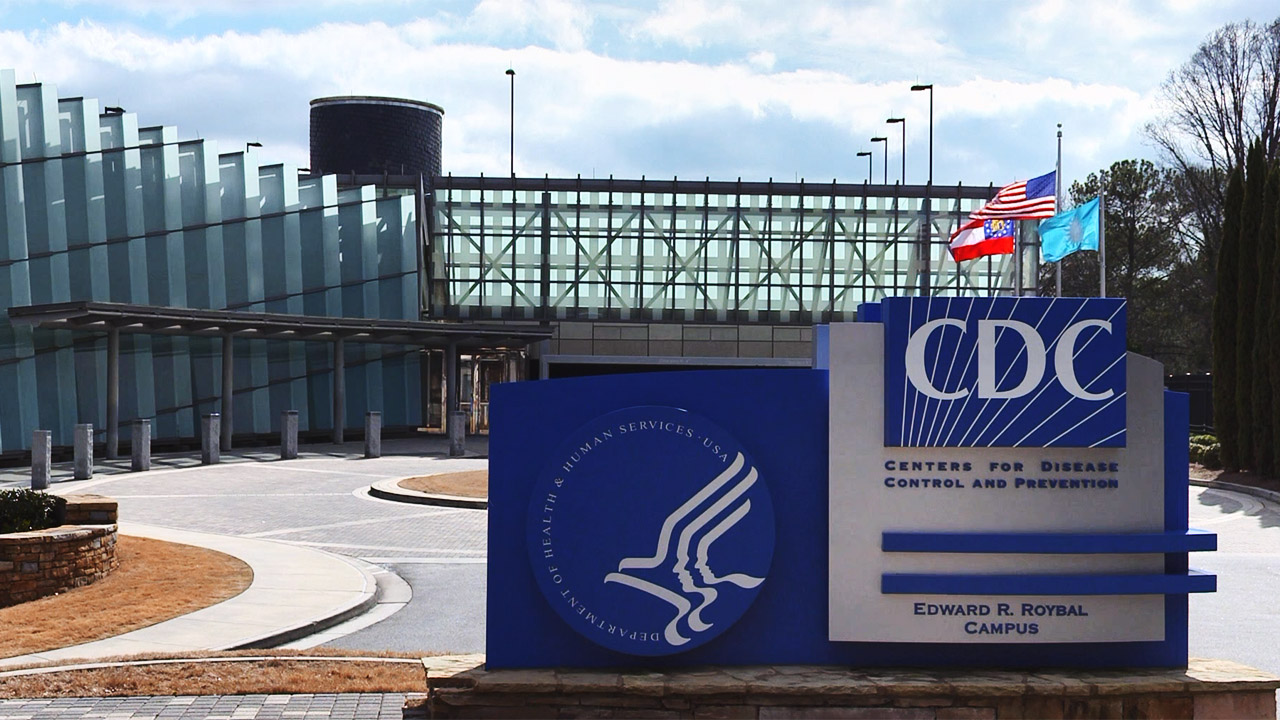
The Centers for Disease Control and Prevention issued a new study report this week that revealed that restricted by employment and housing discrimination and lack of access to needed gender-affirming healthcare for transgender women increasing the risk of contracting HIV.
Researchers reviewed data from a 2019-2020 survey, the National HIV Behavioral Surveillance Among Transgender Women, which found that the demographics of HIV/AIDS have been disproportionally high, especially among Black and Latina trans women, who had experienced employment and housing discrimination coupled with lack of access to gender-affirming healthcare.
The Jan. 25 Morbidity and Mortality Weekly Report was based on data studies of more than 1,600 trans women in seven major urban locales. Participants from Atlanta, Los Angeles, New Orleans, New York, Philadelphia, San Francisco and Seattle were chosen by referrals from people and community-based organizations who knew or were part of the local population of trans women.
The study’s researchers noted: “Employment discrimination occurs at the overlapping nexus of poverty, homelessness, incarceration, health insurance, disability, food insecurity and survival sex work. These issues are interconnected.”
The study stated that trans women’s inability to access quality healthcare, including gender-affirming treatment or access to PrEP, and can expose them to potential incarceration as many turn to “survival sex work” and violence, which increases the risk of contracting HIV.
The study’s author’s pointed out: “When economically marginalized transgender women are refused employment, this refusal cyclically contributes to economic hardships. This analysis …demonstrates the importance of transgender women working and living with dignity and without fear of unfair treatment.”
Health
A Whole New Perspective on Well-Being
The Mather’s team recognizes that everyone’s wellness journey is completely unique to their life experiences and influences.

It’s easy to spot the distinctive, elegant silhouette of The Mather, a Life Plan Community for those 62+ opening this spring in Tysons, Virginia. What is not apparent to the naked eye is The Mather’s unique wellness philosophy, which is literally built into the community.
The Mather’s team recognizes that everyone’s wellness journey is completely unique to their life experiences and influences.
Nature is one of the important factors that contribute to well-being. So The Mather is incorporating biophilic design—a design approach to facilitate access to nature or things that replicate natural patterns. This can include interior spaces with sightlines to a garden, choosing natural wood and stone as interior materials, or incorporating fragrant flowers and plants indoors to spark memories and provide tactile opportunities such as gardening.

“Providing biophilic design within interior settings connects residents to the natural world,” says Mary Leary, CEO and President of Mather, the organization behind The Mather. “Research shows that a connection to nature provides positive benefits to mental states and overall well-being. At The Mather, biophilic design is the intersection of buildings and programs with nature in an urban setting.”
“The Mather is attracting a diverse group of older adults,” says Mary. “As a result, we aim to incorporate wellness practices from around the world, including Wyda movement theory of the Celtic Druids, which helps people achieve harmony with nature and contentment through mindfulness.” This holistic regenerative approach is similar to Qi Gong and yoga, while born in a different part of the world. Mather Institute has a special focus on mindfulness to support older adults’ practice of present moment awareness, which can lead to increased overall well-being, compassion, and joy.
A very different example of a wellness offering at The Mather is the Gharieni Welnamis spa wave bed, which uses computer-controlled vibrational therapy and audio frequencies to train the brain to relax. “The bed increases mindfulness, concentration, and creativity—all of which support our mission of creating Ways to Age Well,SM” says Mary.
These and other personalized ways to wellness will ensure that residents of The Mather can choose from seemingly countless ways to focus on their well-being. In other words, the sky’s the limit!
-

 Africa4 days ago
Africa4 days agoCongolese lawmaker introduces anti-homosexuality bill
-

 District of Columbia14 hours ago
District of Columbia14 hours agoReenactment of first gay rights picket at White House draws interest of tourists
-

 World4 days ago
World4 days agoOut in the World: LGBTQ news from Europe and Asia
-

 Arizona19 hours ago
Arizona19 hours agoAriz. governor vetoes anti-transgender, Ten Commandments bill

